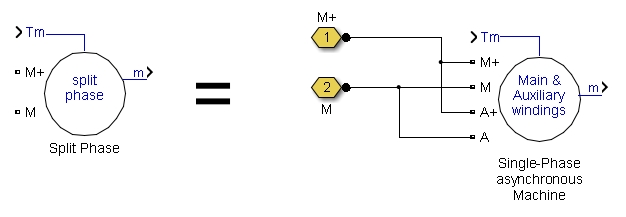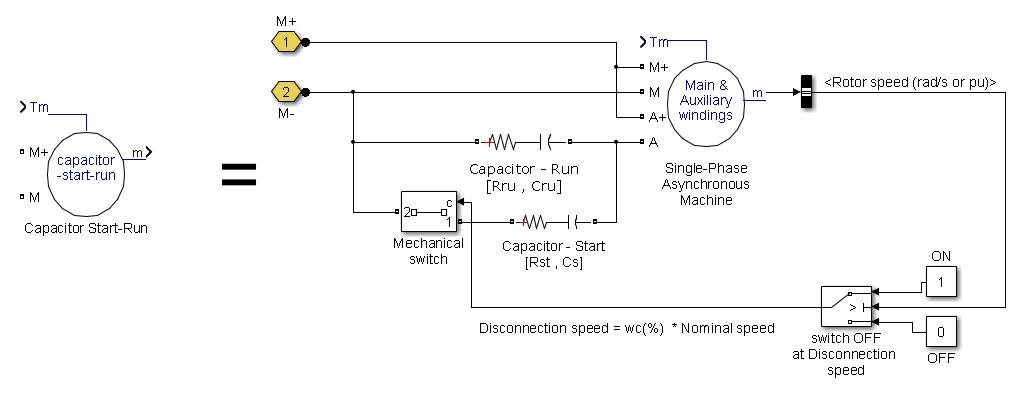Single Phase Asynchronous Machine
(To be removed) Model dynamics of single phase asynchronous machine with squirrel-cage rotor
The Specialized Power Systems library will be removed in R2026a. Use the Simscape™ Electrical™ blocks and functions instead. For more information on updating your models, see Upgrade Specialized Power System Models to use Simscape Electrical Blocks.
Library
Simscape / Electrical / Specialized Power Systems / Electrical Machines
Description
This machine has two windings: main and auxiliary. With the model, you can simulate the split-phase, the capacitor-start, the capacitor-start-capacitor-run, and main & auxiliary windings operation modes.
For the split-phase mode, the main and auxiliary windings are internally connected as follows:

For the capacitor-start mode, the main and auxiliary windings are internally connected as follows:

For the capacitor-start-capacitor-run mode, the main and auxiliary windings are internally connected as follows:

The electrical part of the machine is represented by a fourth-order state-space model and the mechanical part by a second-order system. All electrical variables and parameters are referred to the stator, indicated by the following prime signs in the machine equations. All stator and rotor quantities are in the stator reference frame (dq frame). The subscripts are defined in the following table.
Subscript | Definition |
|---|---|
d | d axis quantity |
q | q axis quantity |
r | Referred to the main winding rotor quantity |
R | Referred to the auxiliary winding rotor quantity |
s | Main winding stator quantity |
S | Auxiliary winding stator quantity |
l | Leakage inductance |
m | Magnetizing inductance |
Electrical System

| Vqs = Rsiqs + dφqs/dt | φqs = Lssiqs + Lmsi'qr | |
| Vds = RSids + dφds/dt | φds = LSSids + LmSi'dr | |
| V'qr = R'ri'qr + dφ'qr/dt – (Ns/NS)ωrφ'dr | φ'qr = L'ri'qr + Lmsiqs | |
| V'dr = R'Ri'dr + dφ'dr/dt + (NS/Ns)ωrφ'qr | where | φ'dr = L'RRi'dr + LmSids |
| Te = p[(NS/Ns)φ'qri'dr – (Ns/NS)φ'dri'qr] | Lss = Lls + Lms | |
| LSS = LlS + LmS | ||
| L'rr = L'lr + Lms | ||
| L'RR = L'lR + LmS |
Mechanical System
Reference frame
The reference frame fixed in the stator converts voltages and currents to the dq frame.
The following relationships describe the ab-to-dq frame transformations applied to the single phase asynchronous machine.
The variable f can represent either voltage, currents, or flux linkage.
The single phase asynchronous machine block parameters are defined as follows (all quantities are referred to the stator).
Parameter | Definition |
|---|---|
Rs, Lls | Main winding stator resistance and leakage inductance |
RS, LlS | Auxiliary winding stator resistance and leakage inductance |
R′r, L′lr | Main winding rotor resistance and leakage inductance |
R′R, L′lR | Auxiliary winding rotor resistance and leakage inductance. The two values are equal to the main winding rotor resistance and leakage inductances values, respectively. |
Lms | Main winding magnetizing inductance |
LmS | Auxiliary winding magnetizing inductance |
Lss, L′rr | Total main winding stator and rotor inductances |
LSS, L′RR | Total auxiliary winding stator and rotor inductances |
Vas ,ias Vbs ,ibs Vqs, iqs | Main winding stator voltage and current Auxiliary winding stator voltage and current q axis stator voltage and current |
V′qr, i′qr | q axis rotor voltage and current |
Vds, ids | d axis stator voltage and current |
V′dr, i′dr | d axis rotor voltage and current |
ϕqs, ϕds | Stator q and d axis fluxes |
ϕ′qr, ϕ′dr | Rotor q and d axis fluxes |
ωm | Angular velocity of the rotor |
Θm | Rotor angular position |
p | Number of pole pairs |
ωr | Electrical angular velocity (ωm x p) |
Θr | Electrical rotor angular position (Θm x p) |
Te | Electromagnetic torque |
Tm | Shaft mechanical torque |
J F | Combined rotor and load inertia coefficient in (kg.m2). Set to infinite to simulate locked rotor. Combined rotor and load viscous friction coefficient. |
H | Combined rotor and load inertia constant in (s). Set to infinite to simulate locked rotor. |
Ns NS Rst Cs Rrun Crun | Number of main winding's effective turns. Number of auxiliary winding's effective turns. Capacitor-Start resistance Capacitor-Start Capacitor-Run resistance Capacitor-Run |
N | Ratio of number of auxiliary winding's effective turns and number of main winding's effective turns. |
Parameters
You can choose between two types of units to specify the electrical and mechanical parameters of the model, the per unit dialog box, and the SI dialog box. Both blocks are modeling the same machine. Depending on the dialog box that you use, Simscape Electrical Specialized Power Systems automatically converts the parameters that you specify into per unit parameters. The Simulink® model of the Single Phase Asynchronous Machine block uses per unit parameters.
Configuration Tab
- Mechanical input
Select the torque applied to the shaft as a Simulink input of the block, or to represent the machine shaft by a Simscape rotational mechanical port.
Select
Torque Tm(default) to specify a torque input, in N.m or in pu, and change labeling of the block input to Tm. The machine speed is determined by the machine Inertia J (or inertia constant H for the pu machine) and by the difference between the applied mechanical torque Tm and the internal electromagnetic torque Te. The sign convention for the mechanical torque is when the speed is positive, a positive torque signal indicates motor mode and a negative signal indicates generator mode.Select
Mechanical rotational portto add to the block a Simscape mechanical rotational port that allows connection of the machine shaft with other Simscape blocks that have mechanical rotational ports. The Simulink input representing the mechanical torque Tm of the machine is then removed from the block.The next figure indicates how to connect an Ideal Torque Source block from the Simscape library to the machine shaft to represent the machine in motor mode, or in generator mode, when the rotor speed is positive.

- Units
Specify the per unit dialog box or the SI dialog box. Default is
SI.- Type of machine
Specify one of the four types of single phase asynchronous machines:
Split Phase(default),Capacitor-Start,Capacitor-Start-Run, orMain & auxiliary windings.- Use signal names to identify bus labels
When this check box is selected, the measurement output uses the signal names to identify the bus labels. Select this option for applications that require bus signal labels to have only alphanumeric characters.
When this check box is cleared (default), the measurement output uses the signal definition to identify the bus labels. The labels contain nonalphanumeric characters that are incompatible with some Simulink applications.
Parameters Tab
- Nominal power, voltage, and frequency
The nominal apparent power Pn (VA), RMS Vn (V), and frequency fn (Hz). Default is
[ .25*746 110 60].- Main winding stator
The stator resistance Rs (Ω or pu) and leakage inductance Lls (H or pu). Default is
[2.02 7.4e-3](SI) and[0.031135 0.042999](pu).- Main winding rotor
The rotor resistance Rr' (Ω or pu) and leakage inductance Llr' (H or pu), both referred to the stator. Default is
[4.12 5.6e-3](SI) and[0.063502 0.03254](pu).- Main winding mutual inductance
The magnetizing inductance Lms (H or pu). Default is
0.1772(SI) and1.0296(pu).- Auxiliary winding stator
The stator resistance RS (Ω or pu) and leakage inductance LlS (H or pu). Note that the Auxiliary winding rotor parameters are assumed to be equal to the main winding rotor resistance and leakage inductances values. Therefore it is not required to specify them in the dialog box. Default is
[7.14 8.5e-3](SI) and[0.11005 0.049391](pu).- Inertia, friction factor, pole pairs, turn ratio (aux/main)
For the SI units dialog box: the combined machine and load inertia coefficient J (kg.m2), the combined viscous friction coefficient F (N.m.s), the number of pole pairs p and ratio of number of auxiliary winding's effective turns, and the number of main winding's effective turns. pu units dialog box: the inertia constant H (s), the combined viscous friction coefficient F (pu), and the number of pole pairs p. Default is
[0.0146 0 2 1.18](SI) and[1.3907 0 2 1.18](pu).- Capacitor-Start
The start capacitance Cs (farad or pu) and capacitor series resistance Rst(Ω or pu). Default is
[2 254.7e-6](SI) and[0.030826 6.2297](pu).- Capacitor-Run
The run capacitance Crun (farad or pu) and series resistance Rrun (farad or pu). Default is
[18 21.1e-6](SI) and[0.27744 0.51608](pu).- Disconnection speed
Specifies the speed (%) when the auxiliary winding may be disconnected. Default is
75.- Initial speed
Specifies the initial speed (%). Default is
0.
Advanced Tab
- Sample time (−1 for inherited)
Specifies the sample time used by the block. To inherit the sample time specified in the Powergui block, set this parameter to
−1(default).
Inputs and Outputs
TmThe Simulink input of the block is the mechanical torque at the machine shaft. When you use the SI parameters mask, the input is a signal in N.m; otherwise it is in pu.
mThe Simulink output of the block is a vector containing measurement signals. You can demultiplex these signals by using the Bus Selector block provided in the Simulink library. Depending on the type of mask you use, the units are in SI, or in pu.
Name
Definition
Units
iar
Rotor current ir_a
A or pu
ibr
Rotor current ir_b
A or pu
iqr
Rotor current iq
A or pu
idr
Rotor current id
A or pu
phiqr
Rotor flux phir_q
V.s or pu
phidr
Rotor flux phir_d
V.s or pu
ias
Main winding stator current ia
A or pu
ibs
Auxiliary winding stator current ib
A or pu
phiqs
Stator flux phis_q(V.s)
V.s or pu
phids
Stator flux phis_d(V.s)
V.s or pu
vc
Voltage capacitor Vc
V or pu
w
Rotor speed
rad/s
Te
Electromagnetic torque Te
N.m or pu
theta
Rotor angle thetam
rad
Limitations
The Single Phase Asynchronous Machine block does not include a representation of iron losses and saturation.
References
[1] Krause, P.C., O. Wasynczuk, and S.D. Sudhoff, Analysis of Electric Machinery, IEEE Press, 1995.